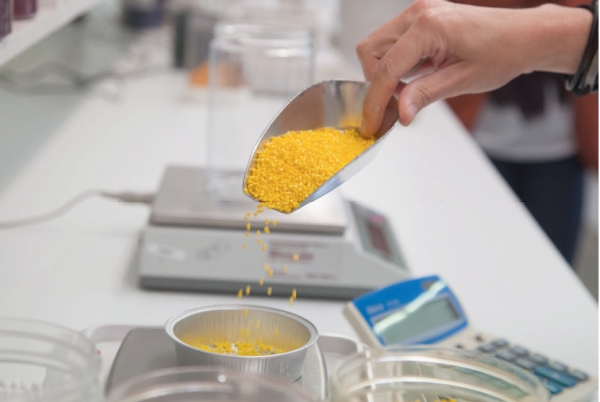Coloristics
They possess supreme discipline in masterbatch operation: Colourists are one of the largest professional groups – their work is the basis for customer satisfaction. They are responsible for mixing the desired colour tone in the laboratory. Despite modern tools such as matching software and colour measurement systems, the colourist still requires keen instincts and a good eye that can distinguish between and evaluate even the smallest colour nuances.
The job
The colourist’s job is complete before an order is even placed. The customer has received a sample quantity of the desired colour concentrate, has tested it in their own production and is satisfied with the result. The actual production of the masterbatch can now begin. Up to that point, the colourist has pulled out all the stops. They are familiar with raw polymer materials and their intrinsic colours and with hundreds of colourants and other additives, such as light protection additives. The customer specifies the colour tone based on colour samples and provides information on the intended use of the plastic part being produced. For example, lightfast pigments are necessary for parts used outdoors. The colourist uses this information together with a lab mixer and extruder to produce a trial batch. This is how they define the formula for production. The masterbatch sample and a test piece are then sent to the customer.
The skills
Anyone who takes up this profession should enjoy colours and consider the search for the right nuance to be an enjoyable challenge, since this is often a very tricky task. For example, how do you create a bluish red that looks brilliant and not muddy? Which base polymer is needed to create a bluish white in the base colouring? Although colour cards and computerassisted formulation systems help, the knowledge of an experienced colourist is indispensable. Their trained eye recognises the slightest differences in colour tone. They often use colour measuring equipment for documentation purposes once their work is complete. The colourist must also be able to relate to customers. After all, the job is about accurately capturing what the customer desires. Colourists who so desire may also work in external sales or the service field. Those who prefer laboratory work can specialise in areas like biopolymers or WPCs (wood-plastic composites).
The training
The colourist profession is a typical lateral entry and advanced training career. Ideally, entrants have professional experience in chemistry, such as training as a chemical laboratory assistant or a degree in chemistry. Experience in plastics processing is also helpful. Otherwise, training entails “learning by doing.” It takes years for the colourist to gain the complete range of knowledge – only to realise that nobody is ever finished learning. The colourist must familiarise themself with and learn to evaluate all the latest effect pigments and biopolymers. Colorists are often a valuable source of information for purchasing, as they are familiar with the properties of the raw materials and can best judge the price/performance ratio. This is important since in addition to the colour required by the customer, the formulation must also be economical.
The path to becoming a certified colourist is paved with training modules, such as those offered by FPL – the research company for pigments and varnishes in Stuttgart – or SKZ in Würzburg. Training involves a high degree of practical experience and covers basic principles such as optimum pigmentation, pigment classes, colour measurement methods and the influence of the injection moulding process on colour. Advanced and five optional training modules are offered to meet the special requirements of individual companies.

Green, blue, red, yellow – if only it were that easy. New colour and effect pigments are constantly being created.
Conclusion
The colourist profession is something for anyone who is willing to work creatively, fast and with care – and who is not at odds with chemistry. If you like to work meticulously and are only satisfied with the best results, you can look forward to exciting tasks and “brilliant results.”

In short
Colourists develop the formula for the masterbatch. They are usually based on a sample object provided by the customer.

A good eye is everything. However: colour is chemistry and physics. Colourists must understand what turns a substance into a pigment.

Chemical lab assistants and chemists can train to become colourists. They gain practical experience in-house.

You can learn everything you need to know about colorimetry, optics, pigment characterisation and much more in seminars that accompany your career.


